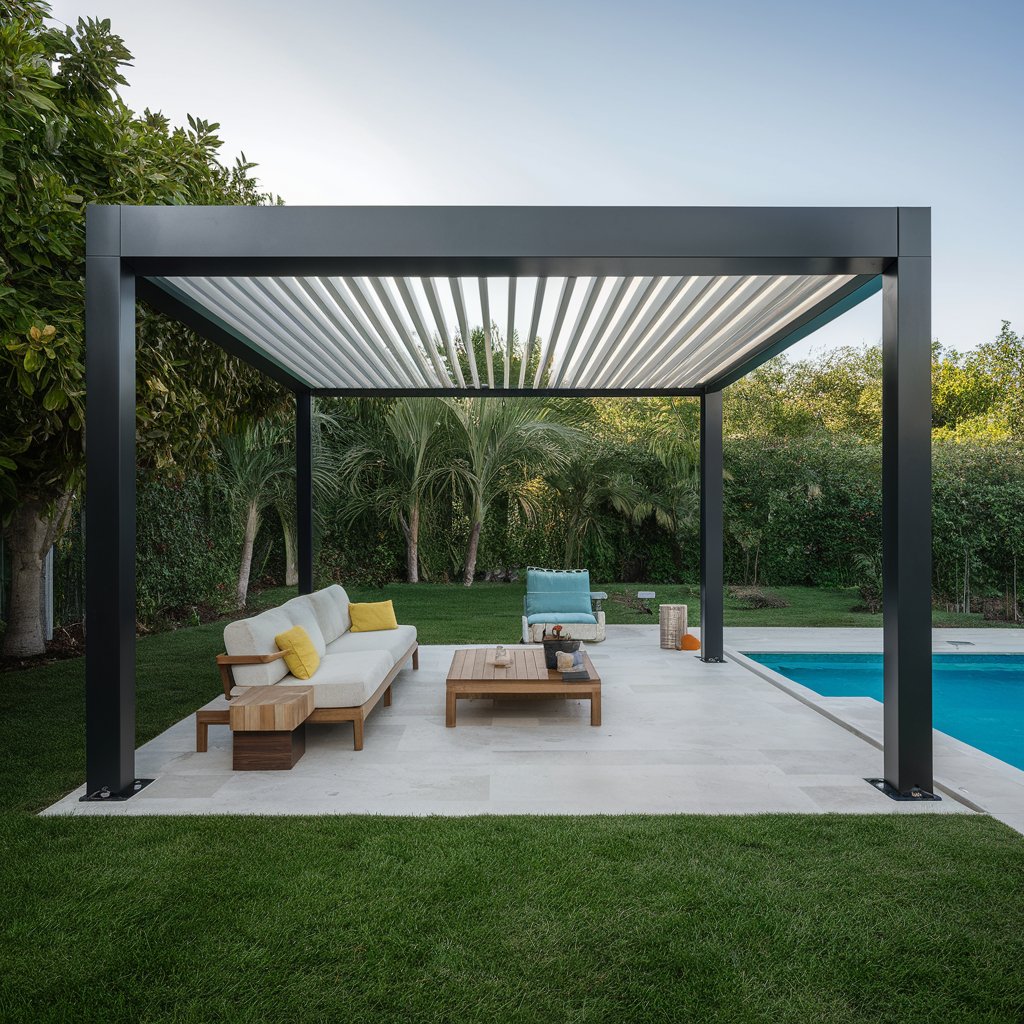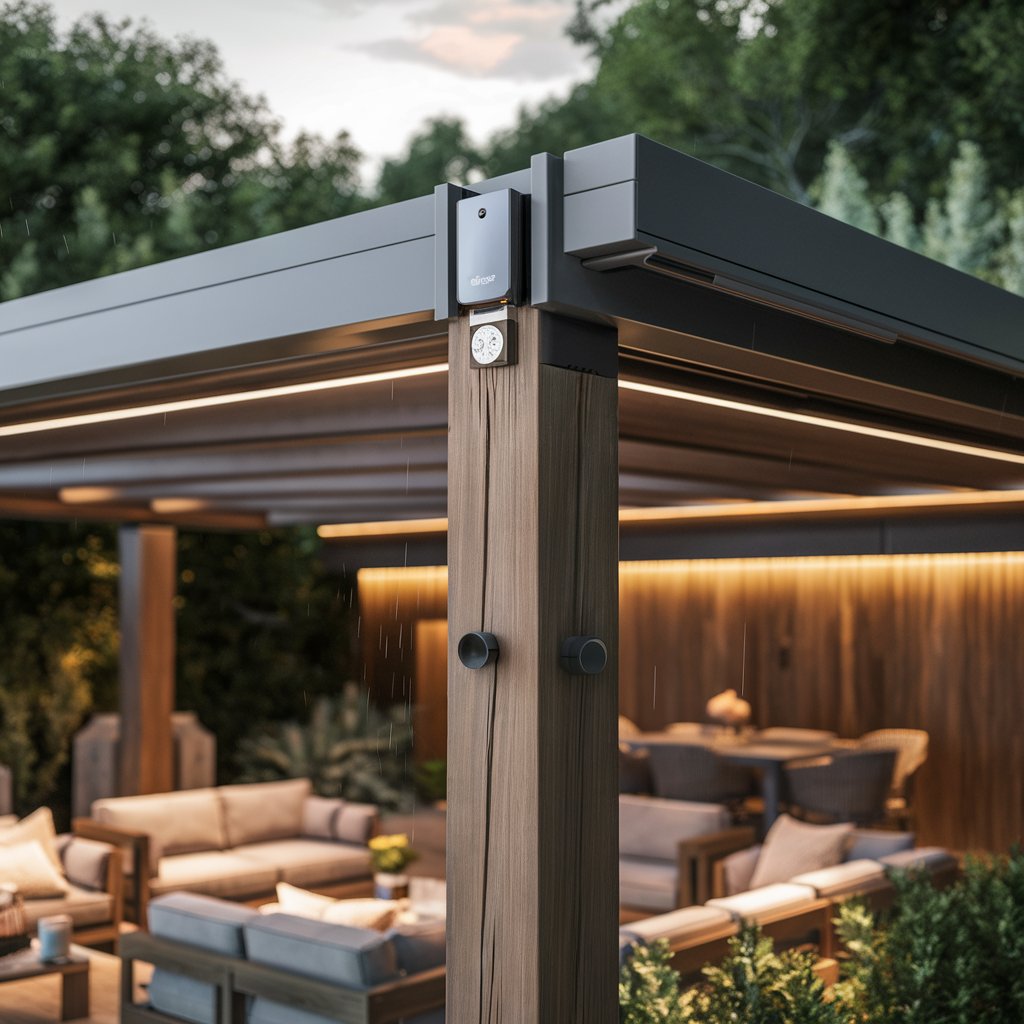metal pergola is a garden feature forming a shaded walkway, passageway, or sitting area, typically with vertical posts or pillars that support cross-beams and a sturdy open lattice, often upon which woody vines are trained. The term “pergola” originates from the Latin word “pergula,” which refers to a projecting eave. Over time, pergolas have evolved to become an essential part of modern landscaping and outdoor living spaces.
History of Pergolas
The concept of pergolas dates back to ancient Egypt, Greece, and Rome, where they were used as functional and decorative garden elements. In ancient Rome, pergolas were integral parts of the homes of the wealthy, offering shaded walkways and spaces for relaxation. During the Italian Renaissance, pergolas became prominent features in the gardens of grand estates and villas, symbolizing luxury and elegance.
Evolution to Metal Pergolas
Traditional pergolas were predominantly made of wood. However, with advancements in materials and technology, metal pergolas have become increasingly popular. The shift towards metal structures is driven by their durability, minimal maintenance, and the ability to achieve contemporary designs that complement modern architecture.
Materials Used in Metal Pergolas
Metal pergolas can be made from various types of metals, each offering unique properties:
- Steel: Steel is a popular choice due to its strength and durability. It can withstand heavy loads and adverse weather conditions. Steel pergolas are often powder-coated to prevent rust and corrosion, extending their lifespan.
- Aluminum: Aluminum is lightweight, corrosion-resistant, and low-maintenance. It’s easy to work with and can be finished in various colors and textures. Aluminum pergolas are ideal for coastal areas where saltwater exposure can cause rusting in other metals.
- Wrought Iron: Wrought iron pergolas are known for their ornate designs and classic appeal. They are incredibly durable but require regular maintenance to prevent rusting.
- Galvanized Steel: This is steel that has been coated with a layer of zinc to protect against corrosion. Galvanized steel pergolas combine strength and longevity, making them a good choice for outdoor structures.
Types of Metal Pergolas
Metal pergolas come in various styles and configurations to suit different needs and preferences:
- Freestanding Pergolas: These pergolas are standalone structures that can be placed anywhere in the garden or patio. They provide a focal point and can be used to create a separate outdoor living or dining area.
- Attached Pergolas: Attached pergolas are connected to the side of a building, such as a house or garage. They extend the living space and can serve as a transition between indoor and outdoor areas.
- Arched Pergolas: These pergolas feature arched beams instead of flat ones, adding an elegant and classical look to the structure. They are often used as entryways or garden features.
- Louvered Pergolas: Louvered pergolas have adjustable slats that can be tilted to control the amount of sunlight and ventilation. They offer flexibility in creating shade and can be equipped with motorized systems for ease of use.
- Custom Pergolas: Custom metal pergolas are designed to fit specific needs and preferences. They can incorporate unique shapes, sizes, and features, such as integrated lighting or retractable canopies.
Design Considerations
When designing a metal pergola, several factors need to be considered to ensure it meets functional and aesthetic requirements:
- Purpose: Determine the primary purpose of the pergola. Will it be used for dining, lounging, gardening, or as a decorative feature? The intended use will influence the size, location, and design of the pergola.
- Location: Choose a location that maximizes the benefits of the pergola. Consider factors such as sunlight, shade, wind, and proximity to the house. A well-placed pergola can enhance the overall layout and functionality of the outdoor space.
- Size: The size of the pergola should be proportional to the space and meet the intended purpose. A larger pergola may be suitable for an expansive garden, while a smaller one might be perfect for a cozy patio.
- Style: Select a style that complements the architecture of the house and the landscape design. Metal pergolas can range from sleek and modern to intricate and traditional.
- Materials and Finish: Choose materials and finishes that are durable and low-maintenance. Powder-coated or galvanized metals are excellent choices for longevity. Consider the color and texture to ensure it harmonizes with other outdoor elements.
- Accessories and Enhancements: Think about additional features such as lighting, curtains, plants, or furniture. These elements can enhance the functionality and aesthetics of the pergola.
Benefits of Metal Pergolas
Metal pergolas offer several advantages over other materials:
- Durability: Metal is extremely durable and can withstand harsh weather conditions, including strong winds, heavy rain, and snow. Unlike wood, it does not rot, warp, or suffer from insect damage.
- Low Maintenance: Metal pergolas require minimal maintenance. A periodic cleaning and inspection for rust (in non-galvanized metals) are usually sufficient to keep them in good condition.
- Aesthetic Appeal: Metal pergolas can be crafted into various designs, from modern minimalist to classic ornate. They can be powder-coated in different colors, allowing customization to match any outdoor decor.
- Strength: Metal pergolas are structurally strong and can support heavy loads, such as climbing plants or additional features like lighting and fans.
- Versatility: Metal pergolas can be used in residential, commercial, and public spaces. They are suitable for gardens, patios, decks, rooftop terraces, and more.
Installation Process
Installing a metal pergola involves several steps:
- Planning and Design: Create a detailed plan and design for the pergola, considering the location, size, and style. Obtain necessary permits if required.
- Site Preparation: Prepare the site by clearing any obstacles and leveling the ground. Mark the positions of the posts using stakes and string.
- Foundation: Depending on the size and weight of the pergola, dig holes for the posts and fill them with concrete to create a stable foundation. Alternatively, use ground anchors or mounting plates for lighter structures.
- Assembly: Assemble the pergola according to the manufacturer’s instructions or the custom design. This typically involves erecting the vertical posts, attaching the beams and rafters, and securing all connections.
- Finishing Touches: Add any additional features such as lighting, curtains, or plants. Ensure all components are securely fastened and the structure is stable.
Maintenance of Metal Pergolas
While metal pergolas are low-maintenance, they still require some care to ensure longevity:
- Cleaning: Regularly clean the pergola with mild soap and water to remove dirt, dust, and debris. Avoid using abrasive cleaners that could damage the finish.
- Inspection: Periodically inspect the pergola for any signs of rust, corrosion, or structural damage. Address any issues promptly to prevent further deterioration.
- Rust Prevention: For steel and wrought iron pergolas, apply a rust inhibitor or repaint with a rust-resistant coating if necessary. Aluminum and galvanized steel pergolas typically do not require this step.
- Plant Care: If using the pergola to support climbing plants, ensure the plants are healthy and not causing damage to the structure. Prune plants regularly to prevent overgrowth.
Applications of Metal Pergolas
Metal pergolas can be used in various settings to enhance outdoor spaces:
- Residential Gardens: Create a shaded area for relaxation, dining, or entertaining. A pergola can serve as a focal point in the garden and provide support for climbing plants.
- Patios and Decks: Extend the living space of a home by adding a pergola to a patio or deck. This creates an inviting outdoor area that can be used year-round with the addition of heating elements or retractable canopies.
- Rooftop Terraces: Maximize the use of rooftop spaces by installing a pergola. This provides shade and a defined area for seating, dining, or gardening.
- Commercial Spaces: Metal pergolas can be used in restaurants, hotels, and other commercial establishments to create attractive and functional outdoor areas for customers.
- Public Parks and Gardens: Enhance public spaces with pergolas that provide shade and seating areas for visitors. They can also serve as architectural features that add beauty and character to the landscape.
Enhancements for Metal Pergolas
To maximize the functionality and aesthetics of a metal pergola, consider these enhancements:
- Lighting: Install outdoor lighting such as string lights, lanterns, or spotlights to create ambiance and extend the use of the pergola into the evening.
- Canopies and Curtains: Add retractable canopies or outdoor curtains for additional shade and privacy. These can be motorized for convenience.
- Fans and Heaters: Incorporate ceiling fans or outdoor heaters to make the pergola comfortable in different weather conditions.
- Furniture: Choose comfortable and weather-resistant furniture to furnish the space under the pergola. Consider dining sets, lounge chairs, or hammocks depending on the intended use.
- Plants: Use the pergola to support climbing plants such as wisteria, jasmine, or grapevines. This adds natural beauty and enhances the structure’s integration with the garden.
- Decorative Elements: Personalize the pergola with decorative elements such as hanging planters, wind chimes, or artwork. These touches add character and make the space uniquely yours.
Conclusion
Metal pergolas are versatile and durable structures that can significantly enhance outdoor spaces. With their modern aesthetic, low maintenance requirements, and customizable designs, they offer a practical and attractive solution for creating shaded areas in gardens, patios, and other outdoor settings. By carefully considering design, installation, and maintenance, you can enjoy the benefits of a metal pergola for years to come.
Whether you’re looking to create a relaxing retreat, a dining area, or a focal point in your garden, a metal pergola is a valuable addition that combines functionality with aesthetic appeal. With the right enhancements and accessories, it can become a favorite spot for enjoying the outdoors, entertaining guests, or simply unwinding in the comfort of your home.


